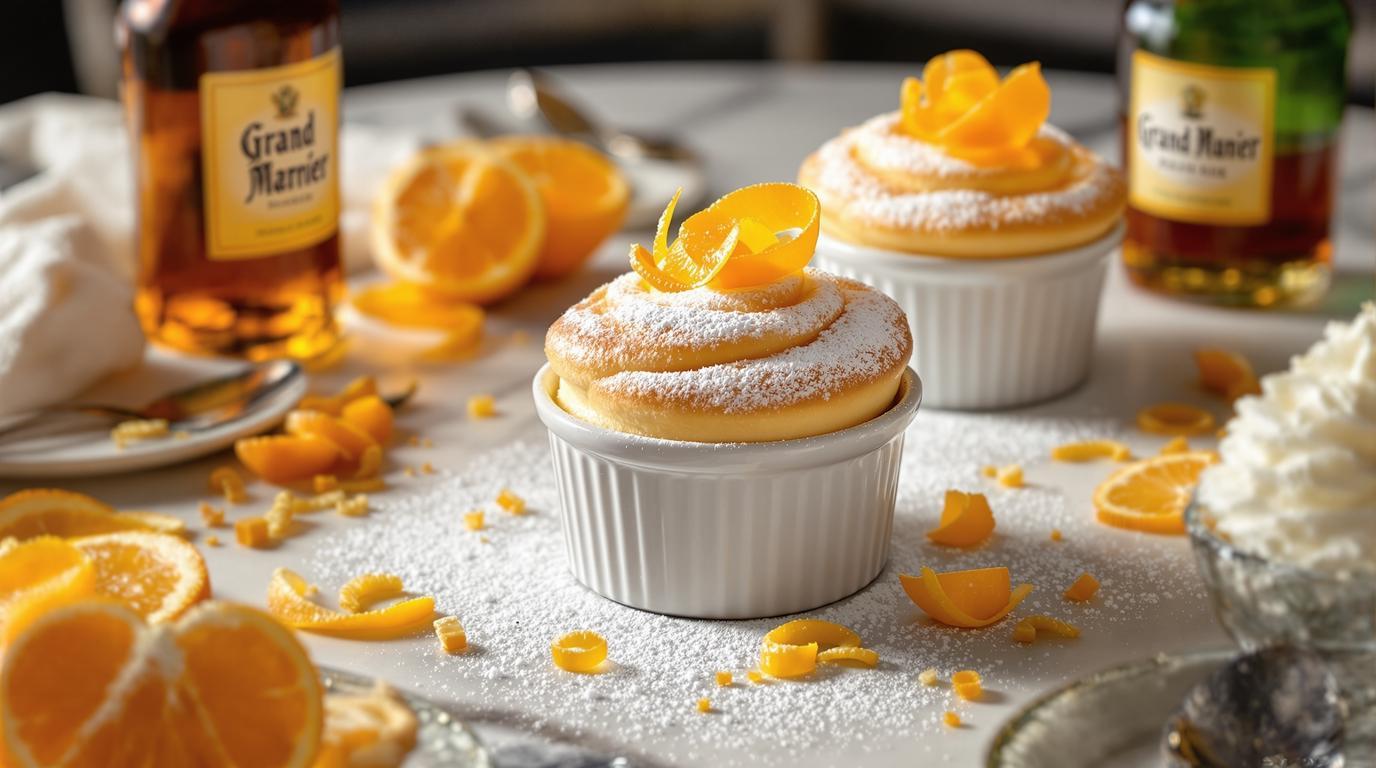The first time I attempted a soufflé glacé au Grand Marnier, I was visiting a small patisserie in Provence where the 70-year-old chef invited me into his kitchen. “This is not about patience,” he told me, gently folding whipped cream into his orange-scented custard. “It’s about respect for the ingredients.” What followed was a revelation—a dessert with the ethereal texture of a soufflé but served frozen, creating this magical contrast between airy structure and cool, melting luxury. The orange liqueur delivered warmth without heaviness, and I’ve been perfecting my version ever since.
The Story
Soufflé glacé has its roots in classic French patisserie, where frozen desserts were given the light, airy qualities we typically associate with baked soufflés. Unlike its hot cousin, this frozen version achieves its signature lift through the incorporation of air via whipped cream rather than beaten egg whites. The Grand Marnier—an orange liqueur developed in 1880—transforms what would be a simple frozen custard into something truly sophisticated, offering complex notes of bitter orange, vanilla, and cognac that develop beautifully when frozen.
Ingredients Spotlight
For 6 servings, you’ll need:
- 6 large egg yolks (room temperature)
- ½ cup (100g) granulated sugar
- ¼ cup (60ml) Grand Marnier
- 2 tbsp (30ml) water
- 2 tsp (10ml) freshly squeezed orange juice
- 1 tsp (5g) orange zest (preferably from organic oranges)
- 1½ cups (350ml) heavy cream (36-40% fat)
- 1 tbsp (15g) confectioners’ sugar
- Candied orange peel for garnish (optional)
The star here is undoubtedly the Grand Marnier—I’ve tried substituting with Cointreau and even homemade orange liqueurs, but nothing quite captures the same magic. If you absolutely must substitute, use equal parts triple sec combined with a few drops of orange extract, though the complexity will suffer somewhat.
Step-by-Step Guide
1. Prepare six 4-oz (120ml) ramekins by wrapping parchment paper around their exteriors, extending about 1 inch (2.5cm) above the rim. Secure with kitchen twine or tape.
2. Create a double boiler by placing a heatproof bowl over a saucepan with 1 inch of simmering water (ensure the bowl doesn’t touch the water). Combine egg yolks, granulated sugar, Grand Marnier, water, orange juice, and zest in the bowl.
3. Whisk constantly until the mixture reaches 165°F (74°C) or until it thickens enough to coat the back of a spoon and leave a clear trail when you run your finger through it—about 8-10 minutes.
4. Remove from heat and place the bowl over an ice bath, stirring occasionally until completely cooled to room temperature (about 15 minutes).
5. In a separate chilled bowl, whip the heavy cream and confectioners’ sugar to stiff peaks—when you lift the beater, the cream should hold its shape without folding over.
6. Using a rubber spatula, fold one-third of the whipped cream into the custard to lighten it, then gently fold in the remaining cream in two additions until just incorporated. You should see no streaks, but be careful not to deflate the mixture.
7. Divide the mixture among the prepared ramekins and freeze for at least 4 hours or overnight.
Chef’s Note: The moment you remove these from the freezer is critical. Let them sit at room temperature for exactly 12 minutes before serving—this creates that perfect melting moment where the exterior softens while the interior maintains structure, similar to how a traditional soufflé has different textures throughout.
Expert Techniques
The double boiler technique is non-negotiable here—direct heat will scramble your eggs. I learned this the hard way during a cooking demonstration when my portable induction burner malfunctioned. What saved me was quickly transferring the mixture to a cold bowl and whisking furiously. The temperature control during custard making is what separates the amateur from the professional.
When folding the whipped cream, use a figure-eight motion with your spatula, rotating the bowl a quarter turn after each fold. This preserves maximum air while ensuring even distribution. I once had a mentor who would count aloud during folding—never exceeding 15 gentle turns to avoid deflation.
For those wanting a similar pillowy texture but with less richness, you can substitute two of the egg yolks with three egg whites, whipped separately and folded in after the cream.
Presentation & Pairing Ideas
Remove the parchment collar just before serving and dust with confectioners’ sugar. For dramatic effect, place a thin slice of candied orange atop each soufflé. The contrast between the pale cream and vibrant orange creates a stunning visual.
Pair with a small glass of Sauternes or, as I prefer, a thimbleful of Grand Marnier served alongside. The dessert also works beautifully with a bitter chocolate sauce—the combination of bitter and sweet echoes the complexity of the Grand Marnier itself.
For a delightful contrast in textures, serve with French sablé cookies or authentic Spanish churros. For breakfast enthusiasts, incorporate elements of this dessert into creative morning dishes or pair with chocolate crème viennoise for the ultimate indulgence.
Remember, a soufflé glacé waits for no one—gather your guests before unmolding, and watch their expressions as they experience that first spoonful of cold, airy perfection melting on their tongues. This is why we cook: to create moments of pure, fleeting joy. ✨🍊
